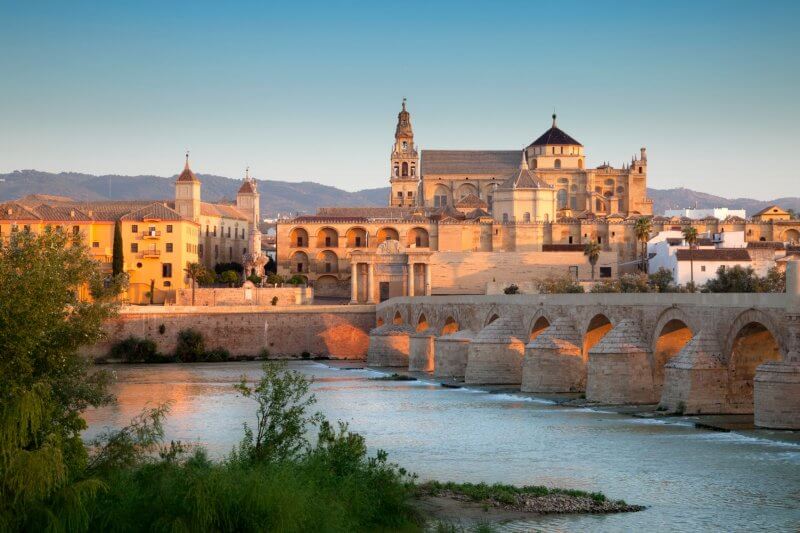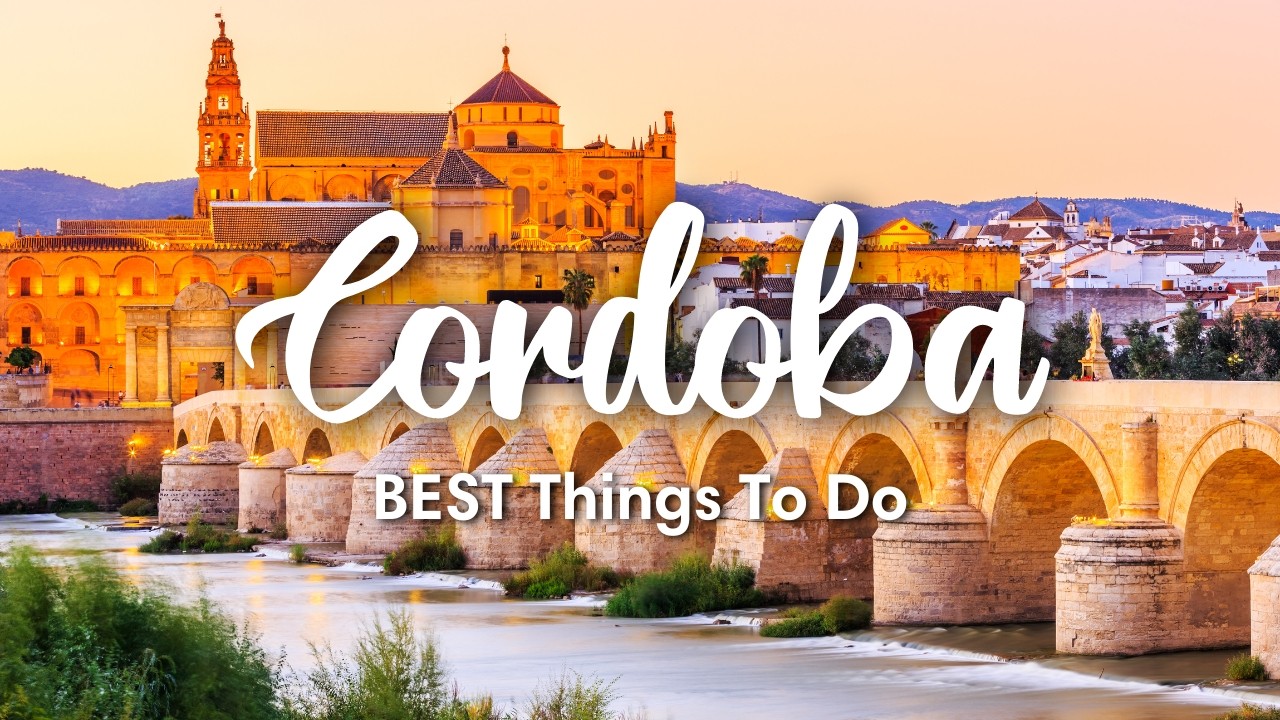Cordoba or Cordoba (Spain) is an ancient city in Andalusia, the capital of the province of the same name in the south of the country. It is located on the right bank of the Guadalquivir River, on the slope of the Sierra Morena.
Cordoba was founded in 152 BC, and throughout its existence, power in it changed several times: it belonged to the Phoenicians, Romans, and Moors.
In terms of size and population, the modern city of Cordoba ranks third in Spain: its area is 1,252 km² and its population is almost 326,000 people.
Along with Seville and Granada, Cordoba is a major tourist center of Andalusia. To this day, Cordoba has preserved a rich heritage of several cultures: Muslim, Christian and Jewish.
Sights of Cordoba
The historic center: squares, courtyards and other attractions
It is in the Old Town that the most important attractions of Cordoba are concentrated. There are numerous museums, horse-drawn carriages drive along narrow cobbled streets, and women in wooden shoes dance flamenco in authentic taverns.
In Old Town, the doors to many patios are left ajar, and you can go in. Sometimes there is a saucer at the entrance for money to maintain order in the patio – everyone throws in as many coins as they can. You should not miss such an opportunity to get to know the life and everyday life of the local population, especially since the Patios de Cordoba are very picturesque! The courtyard design in Cordoba has one feature: flower pots are placed on the walls of the houses. Geranium and hydrangea have remained the most favorite flowers of Cordoban residents for centuries – in the patio you can see these flowers in an unlimited number of shades.
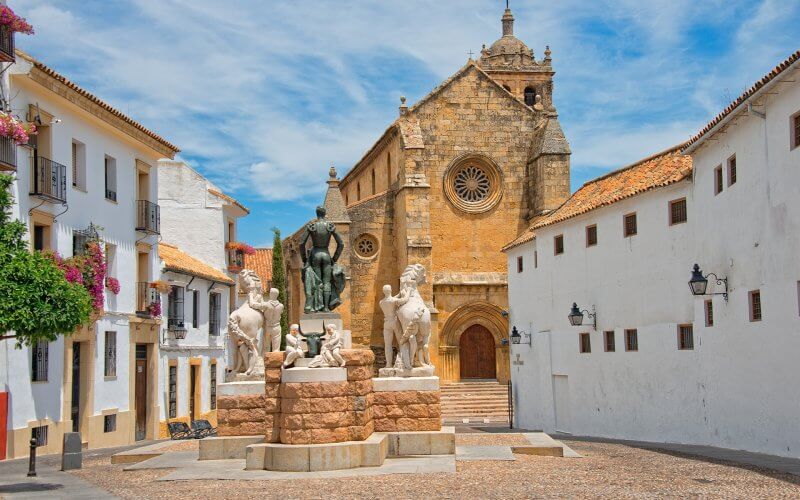
Important! The best time to get to know the Patios de Cordoba is May, when the “Patio Contest” takes place. At this time, even those courtyards that are usually closed at other times are open and specially decorated for visitors. Many tourists believe that in May, the Old Town presents a particularly magnificent spectacle!
The historical center has unique squares, and each of them can be considered a special city landmark:
- Plaza de las Tendillas is a kind of bridge between the Old Town and modern city districts. This main city square is a completely unusual place for Cordoba: spacious, pompous majestic buildings in the Art Nouveau style rise, a beautiful equestrian monument to the famous Spanish commander Gonzalo Fernandez de Cordoba is installed. Plaza de las Tendillas is always noisy, street actors regularly organize performances, and Christmas markets are organized.
- Plaza de la Corredera is another landmark that is not quite typical for Cordoba. The large rectangular Constitution Square, surrounded by identical 4-story buildings with arches, amazes with its scope, straight lines and laconicism. Inquisition executions, bullfights and fairs used to take place here, and now there are numerous nice cafes with open terraces along the entire perimeter of the square.
In the Old Town there is the most beautiful place for “postcard” photos in Cordoba and Spain: the Alley of Flowers. Very narrow, with white houses, which are decorated with an incredible number of bright pots with equally bright live flowers. Calleja de las Flores ends in a small courtyard, from which a picturesque view opens onto one of the main attractions of Cordoba: Mezquita.
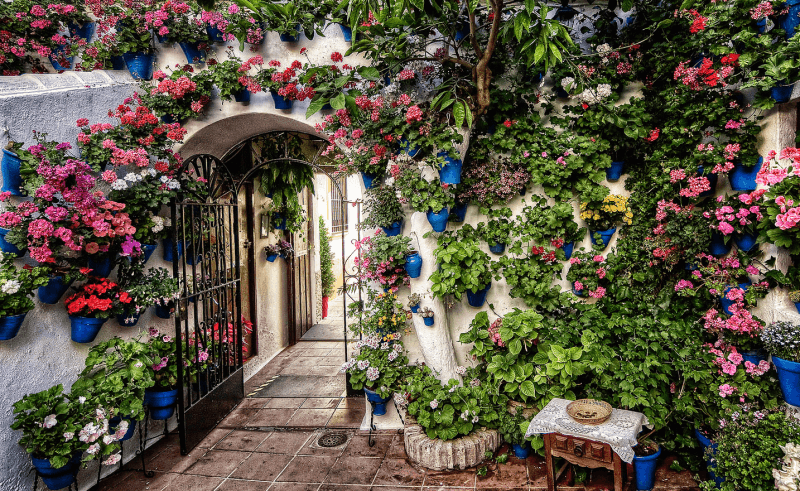
Mezquita is a Roman Catholic cathedral, which is often called a cathedral mosque. This is quite understandable, because due to various historical events, Mezquita can be considered a shrine of various cultures.
Interesting fact! Next to the Mezquita is one of the narrowest streets in Spain – Calleja del Pañuelo, which means Handkerchief Street. Indeed, the width of the street is quite comparable to the dimensions of a handkerchief!
Jewish Quarter
The colorful Jewish Quarter, the Juderia district, is recognized as a special part of the Old Town.
It cannot be confused with other city districts: the streets are even narrower, there are countless arches, many houses are windowless, and if there are windows, they are barred. The preserved architecture allows us to understand how Jewish families lived here in the 10th–15th centuries.
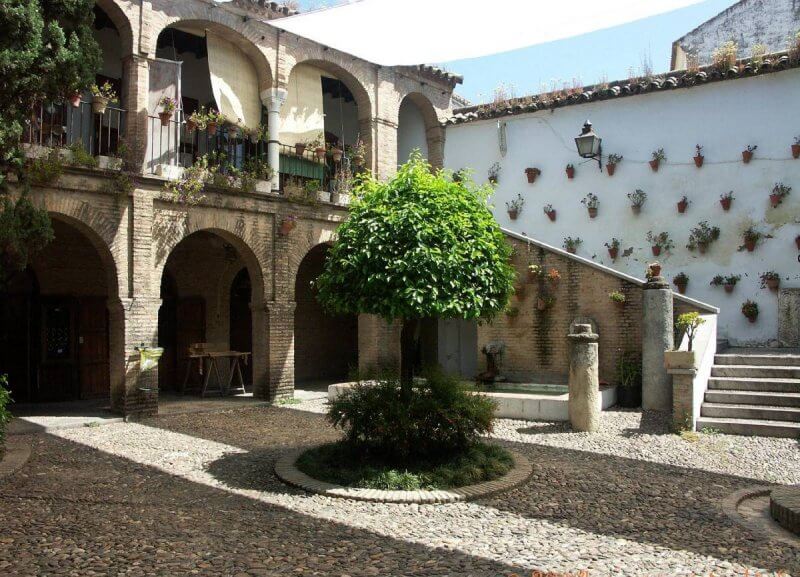
The Juderia area has many interesting sights: the Jewish Museum, the Sephardic House, the Almodóvar Gate, the Seneca monument, and the most famous bodega (wine shop) in Cordoba.
It is impossible not to mention the famous synagogue, the only one preserved in its original form in Andalusia, and one of only three remaining in all of Spain. It is located on Calle Judíos, No. 20. Admission is free, but it is closed on Mondays.
Advice! The Jewish Quarter is one of the most popular tourist destinations, and during rush hour, all those wishing to go simply physically do not fit on the small streets. To get to know the Juderia area, it is better to choose early morning.
Alcazar of the Christian Monarchs in Cordoba
In the form that the Alcázar de los Reyes Cristianos has today, it was started by Alfonso XI in 1328. And as a basis, the king used a Moorish fortress, built on the foundations of a Roman citadel. The Alcázar’s landmark is the palace itself, with an area of 4,100 m², and the gardens, which stretch over 55,000 m².
At its base, the Alcazar castle has the shape of a perfect square with towers at the corners:
- Tower of Respect – the main tower, which houses a reception hall;
- The Inquisition Tower is the tallest of all. Its open terrace was used for public executions;
- Lions Tower – the oldest palace tower in the Moorish and Gothic styles;
- The Dove Tower, destroyed in the 19th century.
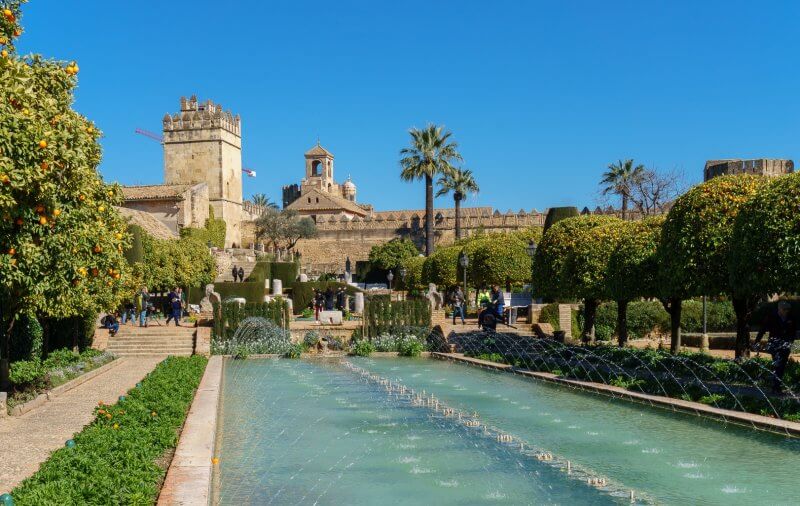
The interior of the Alcazar is well preserved. There are mosaics, galleries with sculptures and bas-reliefs, a unique ancient Roman sarcophagus from the 3rd century A.D. made from a single piece of marble, and many antiques.
Hidden within the defensive walls are picturesque Moorish-style gardens with cascading fountains, ponds, flowering alleys, and sculptures.
- The Alcazar complex is located in the very center of the Old City, at the address: Calle de las Caballerizas Reales, s/n 14004 Cordoba, Spain.
- Children under 13 are admitted free of charge, adult tickets cost €5.
You can visit the attraction at the following times:
- Tuesday-Friday – from 8:15 to 20:00;
- Saturday – from 9:00 to 18:00;
- Sunday – from 8:15 to 14:45.
Roman Bridge
In the center of the Old Town, a squat, massive 16-arch bridge spans the Guadalquivir River, 250 m long and with a “useful” width of 7 m. The bridge was built during the Roman Empire, hence the name – Puente Romano.
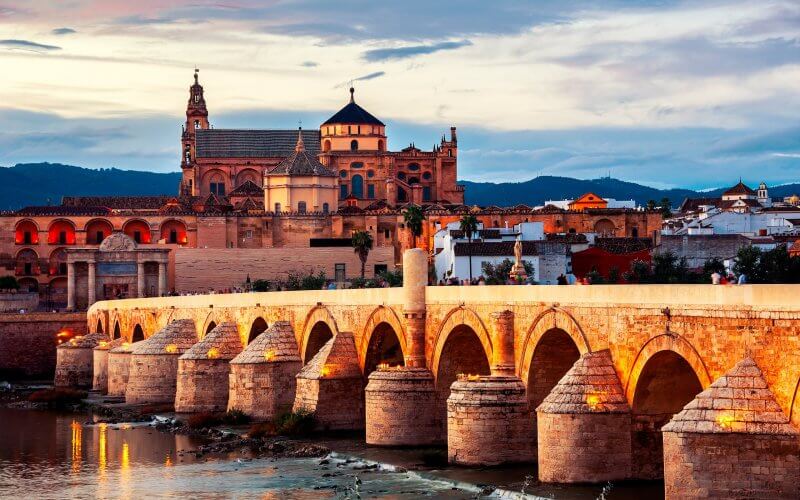
Interesting fact! The Roman Bridge is a landmark of Cordoba. For almost 20 centuries it was the only one in the city, until the St. Raphael Bridge was built in the 20th century.
In the middle of the Roman Bridge, a sculpture of the patron saint of Cordoba, the Archangel Raphael, was installed in 1651. Flowers are always placed in front of the statue and candles are lit.
On one bank the bridge ends with the Puerta del Puente gate, on both sides of which the remains of the medieval fortress wall are visible. At its other end is the Calahorra Tower, which offers the most impressive view of the bridge.
Since 2004, the Roman Bridge has been entirely pedestrian. It is open 24 hours a day and is completely free to cross.
Calahorra Tower
Torre de la Calahorra, located on the southern bank of the Guadalquivir River, is the oldest urban fortification, dating back to the 12th century.
The base of this structure is in the shape of a Latin cross with three wings united by a central cylinder.
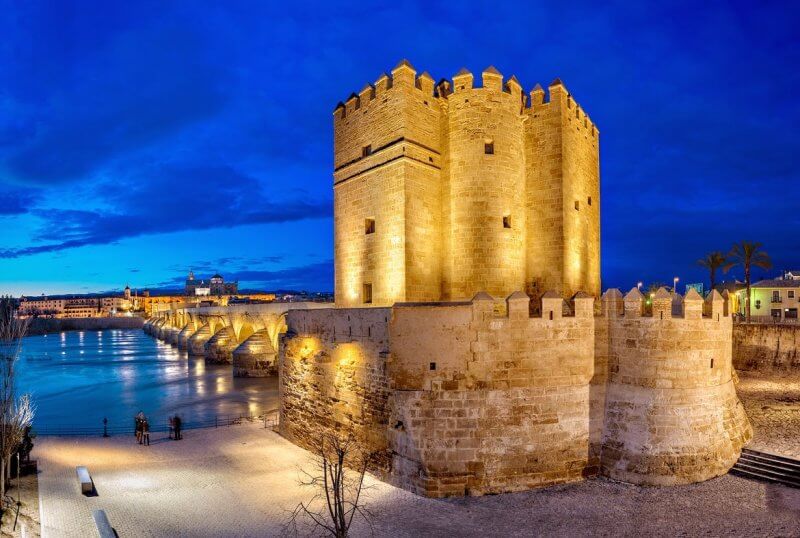
Inside the tower is another landmark of Cordoba: the Museum of the Three Cultures. In 14 spacious rooms, exhibits are presented that tell about different periods of the history of Andalusia. Among other exhibits, there are examples of inventions from the Middle Ages: models of dams that are still in use in some cities in Spain, surgical instruments that are still used in medicine.
At the end of the tour, museum visitors will be taken to the roof of the tower, where Cordoba and its sights can be seen at a glance. To get to the observation deck, you will have to climb 78 steps, but the views are worth it!
- Address of the Calaora Tower: Puente Romano, S/N, 14009 Cordoba, Spain.
- Entrance fees: adults €4.50, students and pensioners €3, children under 8 years old – free.
The museum is open daily:
- from October 1 to May 1 – from 10:00 to 18:00;
- from May 1 to September 30 – from 10:00 to 20:30, break from 14:00 to 16:30.
Viana Palace
Palacio Museo de Viana is a museum in the Viana Palace. In the luxurious interiors of the palace you can see the richest collection of rare furniture, paintings of the Bruegel school, unique tapestries, examples of ancient weapons and porcelain, a collection of rare books and other antiques.
The Viana Palace has an area of 6,500 m², of which 4,000 m² are occupied by internal courtyards.
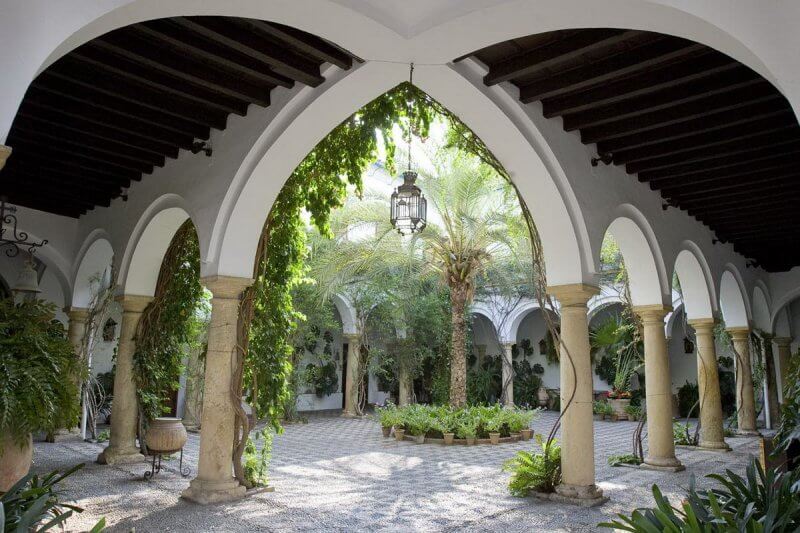
All 12 courtyards are surrounded by greenery and flowers, but each one is decorated in an individual and completely unique style.
Address of the Viana Palace: Plaza de Don Gome, 2, 14001 Cordoba, Spain.
The attraction is open:
- in July and August: from Tuesday to Sunday inclusive from 9:00 to 15:00;
- all other months of the year: Tuesday-Saturday from 10:00 to 19:00, Sunday from 10:00 to 15:00.
Children under 10 and pensioners can visit the Palacio Museo de Viana for free, for other visitors:
- inspection of the interior of the palace – €6;
- patio viewing – €6;
- combined ticket – 10 €.
On Wednesdays from 2:00 PM to 5:00 PM there are happy hours, when admission is free for everyone, but tours inside the palace are limited. Details are on the official website www.palaciodeviana.com.
Victoria Market

Like any market in southern Spain, Mercado Victoria is not only a place to buy food, but also a place to relax and eat. There are many cafes and pavilions with delicious and varied food in this market. There are dishes from different cuisines of the world: from national Spanish to Arabic and Japanese. There are tapas (sandwiches), salmoreteca, dried and salted fish, as well as fresh fish dishes. Local beer is sold, and if you want, you can drink cava (champagne). It is very convenient that samples of all the dishes are on display – this makes the problem of choice much easier.
Victoria Market is very popular, which is why the prices here are not the cheapest.
Address of the gastronomic attraction: Jardines de La Victoria, Cordoba, Spain.
Opening hours:
- from June 15 to September 15: from Sunday to Tuesday inclusive – from 11:00 to 1:00, on Friday and Saturday – from 11:00 to 2:00;
- From September 15 to June 15 the schedule is the same, the only difference is that the opening time is 10:00.
Madina az-Zahra
Just 8 km west of Cordoba, at the foot of the Sierra Morena, is the former palace city of Madina az-Zahra (Medina Azahara). The Medina Azahara historical complex is a monument to the Arab-Muslim period of Spain, one of the most significant attractions of Cordoba and Andalusia.
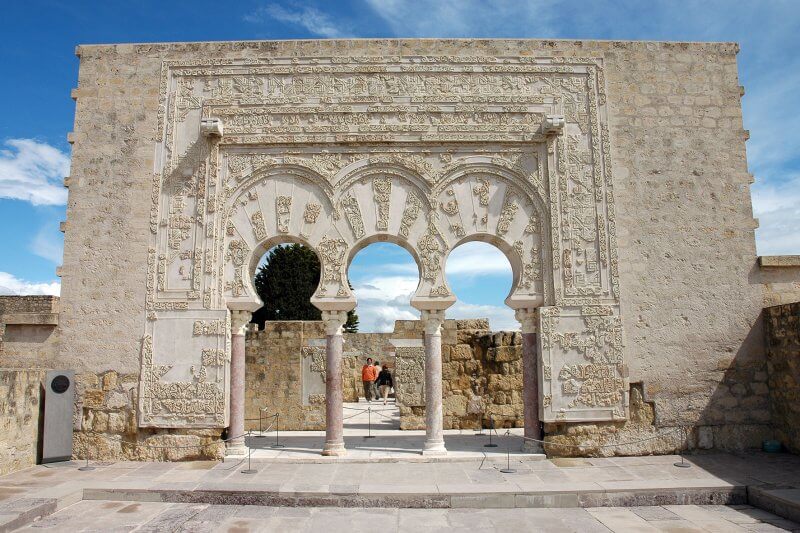
The medieval Arab palace complex of Madina az-Zahra, which served as a symbol of the power of Islamic Cordoba in the 10th century, stands half-ruined. But what is available for inspection has a majestic and impressive appearance: the Rich Hall and the House with the Reservoir – the residence of the caliph, the House of the Viziers with rich dwellings, the remains of the Alhama mosque, the beautiful basilica of the House of Jafar with an open courtyard, the Royal House – the residence of the caliph Abd ar-Rahman III with many rooms and portals.
The Medina Azahara Museum is located next to the historical complex. It displays various finds from archaeologists who excavated Medina az-Zahra.
Advice! To see the ruins of the complex and the museum, 3.5 hours is enough. Since the climate is hot and the ruins are in the open air, it is better to plan a trip to the attraction for early morning. It is also advisable to take hats to protect from the sun and water.
- Address of the historical landmark: Carretera de Palma del Río, km 5.5, 14005 Cordoba, Spain.
- Opening hours: Tuesday through Saturday inclusive – from 9:00 to 18:30, Sunday – from 9:00 to 15:30.
- A visit to the palace city is subject to a fee, entrance fee is €1.5.
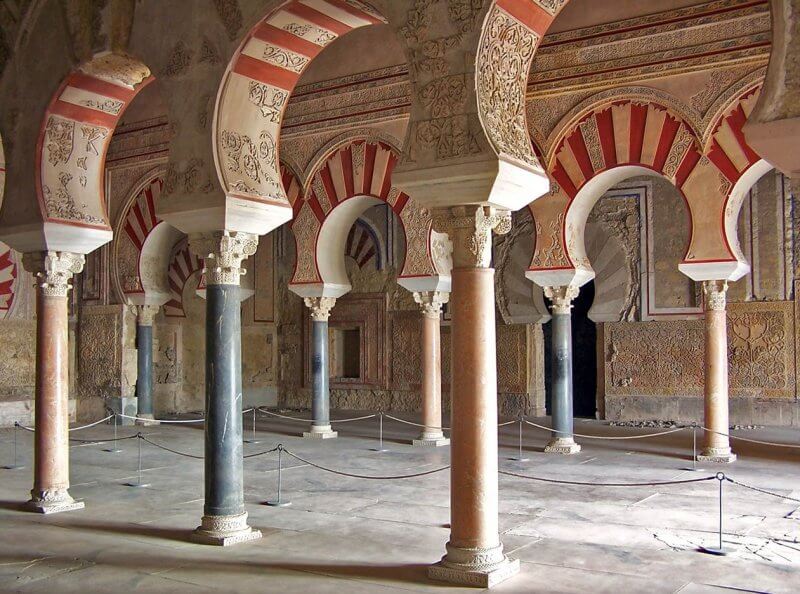
You can get to Medina Azahara by tourist bus, which leaves from the center of Cordoba, from Glorieta Cruz Roja at 10:15 and 11:00. The bus goes back to Cordoba at 13:30 and 14:15. Tickets are sold at the tourist center, their price includes transportation in both directions and a visit to the historical complex: for adults 8.5 €, for children 5-12 years old – 2.5 €.
Where to stay in Cordoba
The city of Cordoba offers different options for accommodation: there are many hotel offers, both very luxurious and modest, but comfortable aparthotels. The bulk (99%) of all hostels and hotels are concentrated in the Old Town, and very few (1%) are in the modern Vial Norte district located near the center.
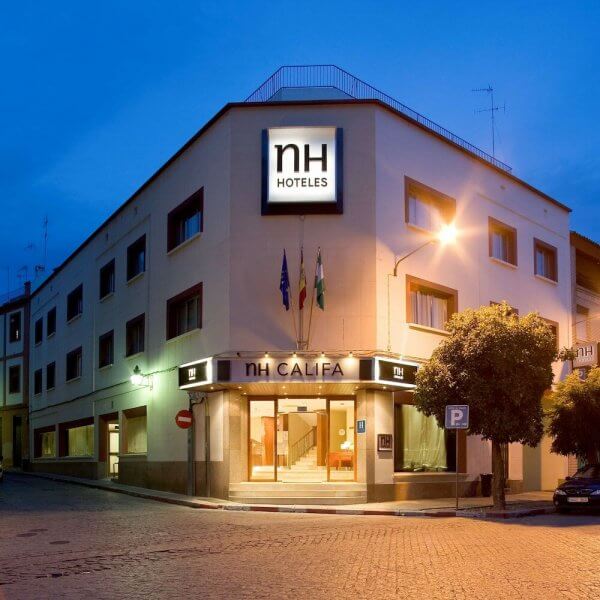
Almost all the accommodation in Old Town is Andalusian in style: with arches and other Moorish elements, with small gardens and fountains in cool, cozy courtyards. Even the Hospes Palacio del Bailio hotel (one of two 5* hotels in Cordoba) is not located in a new building, but in a 16th-century palace. The cost of double rooms in this hotel starts from €220 per night. In 3* hotels, you can rent a double room for €40-70 per night.
The northern district of Vial Norte is more suitable for those who are stopping in Cordoba for a day and who are not very interested in historical sights. There are railway and bus stations, many shopping centers, and prestigious restaurants. In the 5* Eurostars Palace hotel located here, a double room will cost from €70 per night. A more modest double room in one of the 3* hotels will cost €39-60.
Transport links to Cordoba
Railway
The connection between Madrid and Cordoba, located 400 km apart, is provided by high-speed trains of the AVE type. They depart from Madrid Puerta de Atocha railway station every 30 minutes, from 6:00 to 21:25. You can travel from one city to the other in 1 hour 45 minutes and for 30-70 €.
From Seville, high-speed AVE trains depart from Santa Justa station 3 times an hour, starting at 6:00 and ending at 21:35. The train takes 40 minutes and the ticket costs 25-35 €.
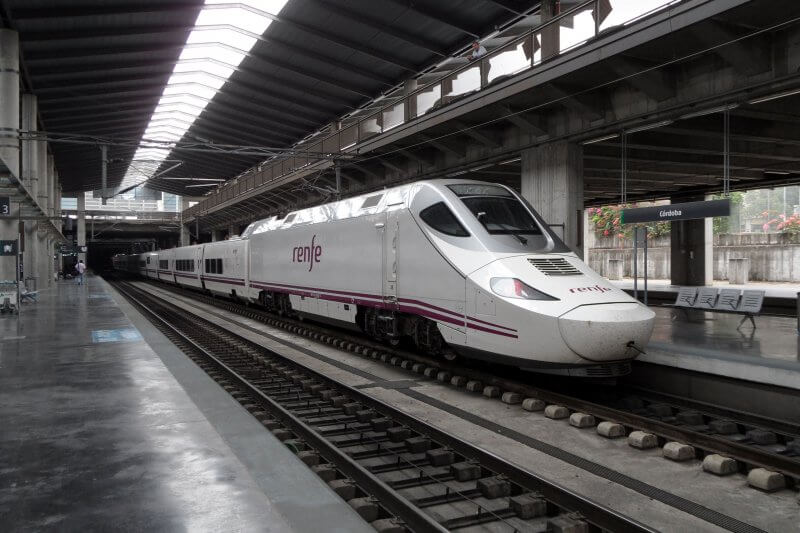
All timetables can be viewed on the Spanish National Railways service Raileurope: www.raileurope-world.com/. You can buy a ticket for a suitable route on the website, but you can also do this at the ticket office at the railway station.
Bus service
The bus service between Cordoba and Madrid is provided by the carrier Socibus. On the Socibus website (www.busbud.com) you can see the exact schedule and buy tickets in advance. The trip takes 5 hours, the ticket price is about 15 €.
Alsa operates from Seville. There are 7 departures from Seville, the first at 8:30. The journey takes 2 hours, tickets cost €15-22. Alsa website for schedules and online ticket purchase: www.alsa.com.
How to get to Cordoba from Malaga
The closest international airport to Cordoba is located 160 km away, in Malaga, and this is where foreign tourists usually fly in. Malaga and Cordoba are connected by well-established road and rail links.
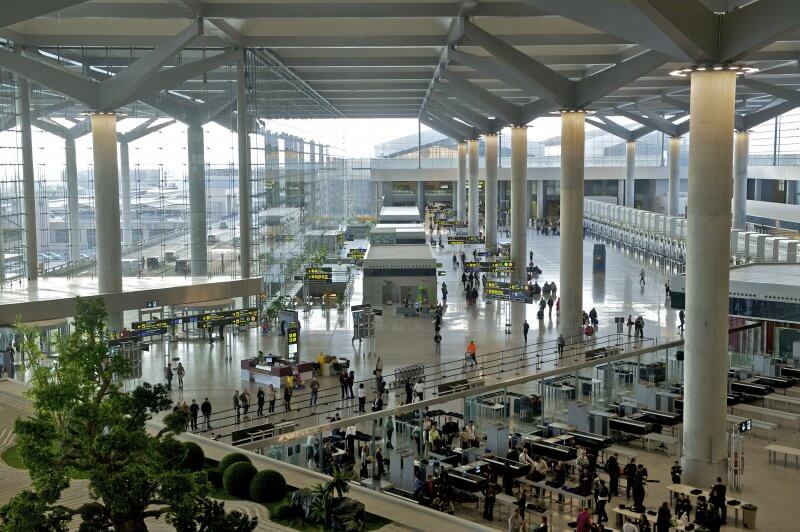
Having landed at Malaga airport, you need to go to the Renfe Cercanias Malaga stop in Terminal 3 (you can navigate by the Train signs). From this stop, train C1 departs from line 1 to the central railway station of Malaga Maria Zambrano (journey time 12 minutes, trains every 30 minutes). From the Maria Zambrano station there are direct trains to Cordoba (journey time 1 hour), trains are every 30-60 minutes, from 6:00 to 20:00. You can see the schedule on the Spanish Railways service Raileurope: www.raileurope-world.com. On this website, or at the railway station (at the ticket office or a special machine) you can buy a ticket, its cost is 18-28 €.
You can also get from Malaga to Cordoba by bus – they leave from Paseo del Parque, which is next to the Sea Square. There are several departures a day, the first at 9:00. Ticket prices start from €16, and the travel time depends on the traffic on the road and is 2-4 hours. Alsa is the company that provides transportation from Malaga to Cordoba (Spain). On the website www.alsa.com you can not only see the schedule, but also book tickets in advance.
Discover Santiago de Compostela: The Heart of Pilgrimage in Spain

